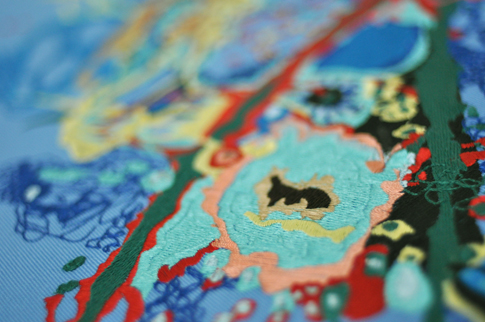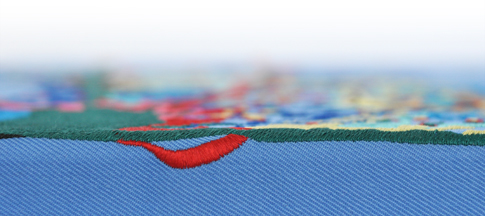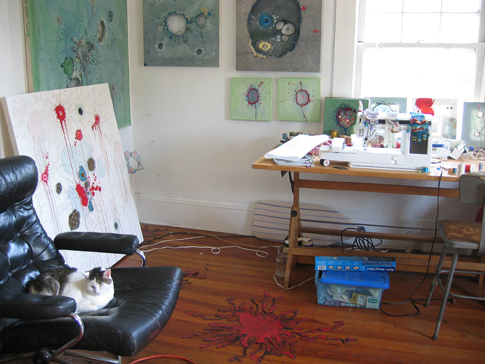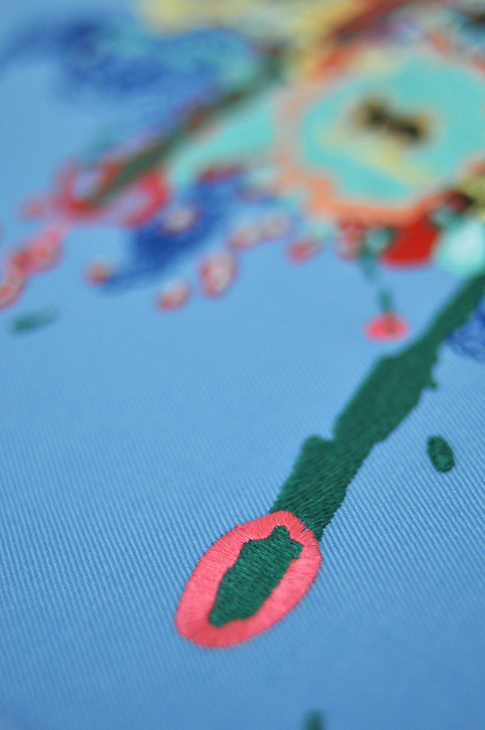Right and wrong, good and evil—maybe I have always been one drawn to the gray area of life. Likely that is at the heart of what draws me to the art world. I am attracted to contradictions and aspects of life that are complicated—not simplified into categories of black and white. The work of Nava Lubelski is rich in contradictions—just the kind that make it a very compelling artwork.
Old Tricks for New Monkeys is a vibrant canvas with colors seemingly caught in motion. Beautifully detailed threads create a palette that pulls the viewer in and keeps the eye engaged. Yet even the title of the piece is a juxtaposition of opposites; and this gives a sense of the multiple contradictions that build layers of content beyond the visual itself.
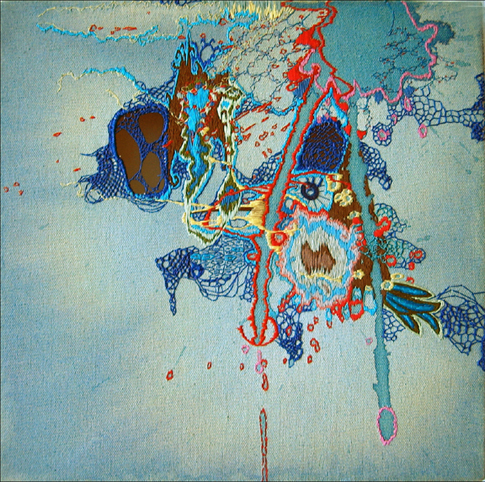
Monkey See and Do, 12″ x 12″, thread on canvas, 2006. Image courtesy of the artist.
This work began as organic stains on fabric that were then hand embroidered by the artist. The process of embroidery is a laborious one, at once meticulous and fine. So from first glance one sense’s the accidental nature of a stain, and begins appreciating the shape and color, only to find that there is a complicated handiwork involved, one with very intentional impulses. The artist has said about her own work in general,
I love art that encourages a perceptual shift in the viewer, particularly a humorous one. My work in a certain sense is a one-line joke about the rewards of “looking closer,” although obviously it’s really labor intensive and complicated as well. I began this technique as an outgrowth of painting and then collaging with fabric, but I got interested in thread and the tiny, rigid structures of the stitches. I became curious about why stitching was always stigmatized as decorative and crafty – I went about finding the least practical, least structured, least controlled graphic imagery that I could embroider and happened upon the “drip.” I liked the idea that from a distance the pieces would look so fluid and painterly, but contain this surprise of shockingly time-consuming deliberation.
Karen Rosenberg’s 2009 NY Times review places Lubelski’s work in the art historical category of artists who ‘paint’ with thread, such as Ghada Amer and Michael Raedecker. The review also illustrates the relation of masculine and feminine elements inherent in her work, as in the ‘male arts of paint-splashing’ and the ‘female fabric-staining and needlework’. There is a tension between the feminine and masculine aspects of the work that grows stronger with the introduction of the digital medium.
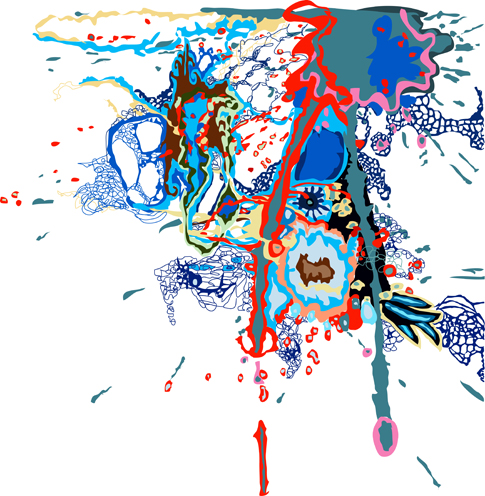
Monkey See and Do, digital tracing, 2010. Image courtesy of the artist.
In order to produce this work for The Present Group, Lubelski chose to work with a machine to embroider her original design. She began by doing a computer drawing that was a tracing of an earlier piece that she had stitched by hand in response to an organic stain, wanting to see what would happen if she fed that drawing into a computer stitching program without any changes or explanations. In the context of her process, she was letting go of control and trusting the machine to reproduce an image in its own way. Lubelski described this change in process as simultaneously embracing chaos and control.
Is something lost in the translation of the machines paths, something that existed in the hand-embroidered stitches? Or is the translation actually more direct due to the nature of the process? Does the machine embroidery change the value of the piece? Much has been written in postmodern theory about the loss of the original in nearly every medium from film to painting. As Baudrillard referenced,
“The simulacrum is never that which conceals the truth–it is the truth which conceals that there is none. The simulacrum is true—Ecclesiastes.”
Postmodern theorists often looked to production and reproduction and the inevitable commercialization of art. But the conclusion was that the loss of the original does not signify a bad thing, it opens up progressive possibilities of both process and accessibility.
In Old Tricks for New Monkeys, the beauty and wonder of the handmade is still inherent. In fact, digital media here combines the skills of the artist and the machine and expands the artistic practice. Lubelski successfully integrates the feminine and the masculine, the analog and the digital, the original and the reproduction, not favoring one over the other, but developing an artwork full of seemingly opposite threads that provide room for visual and conceptual dialog.
.
.
Jennifer McCabe is currently Executive Director and Chief Curator of the Museum of Craft and Folk Art in San Francisco, where she has been working for three years to develop new programs and expand the image of the 26-year old institution. She is also an adjunct professor in contemporary art, most recently at Mills College. www.mocfa.org
